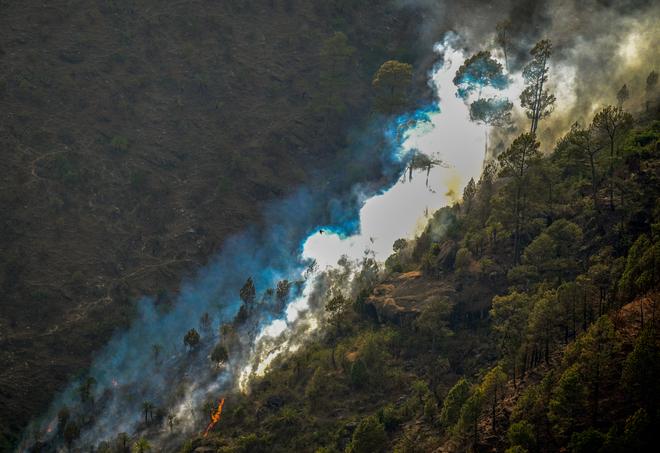On May 2, Gyanu Chalaune and his wife Basanti trudged up the hills in Sunrakot village in the scenic district of Almora in Uttarakhand to collect resin from the chir pine trees in the forest. The couple had moved from Nepal to Uttarakhand just last year for a better life and education for their three children. The temperature that morning was above 30°C. They worked to extract the resin, called leesa in the hills, for Ramesh Bakuni, a contractor. They earned ₹50,000-60,000 if they worked for 10 hours a day for six months.

As they were getting ready to leave, the couple heard a scream. They saw a man running on the hilltop, desperately trying to shake off flames that had engulfed him. They realised with horror that he was Deepak Pujara, a friend. The Chalaunes scrambled to the hilltop and found Pujara’s wife, Tara, lying on the ground, half burnt. Quickly, they broke a green branch off a nearby tree and began hitting Pujara, even as their clothes caught fire. Before anyone could help them, the four victims were severely burnt. All of them succumbed to injuries in hospital.
Bakuni did not have the courage to break the news to Chalaune’s children for days. “They have been playing in my garden for months. I didn’t have the heart to tell them what had happened,” says Bakuni, who is worried that people will no longer work for him. The children are now under the care of their uncle in Nepal’s Bajhang district, from where they came.
Five people have been killed and four injured in forest fires in Uttarakhand this year. According to a 2019 report of the Forest Survey of India, Uttarakhand has a recorded forest area of 38,000 square kilometres, which is 71.05% of its geographical area. Since November 2023, when forest fires began to rage, there have been 1,038 incidents that have gutted 1,385.5 hectares (ha) of forest land till May 10. While authorities have dismissed these as “annual affairs” in the hills, the cost of these fires has been borne by the people whose lives depend on the mountains.
Flame of the forest
A booklet on the Uttarakhand forest department website says increasing migration of people from here to other States, which has left the hills barren; high-tension wires; and the abundance of chir pine trees, which are highly inflammable in nature, are the main reasons for forest fires. While the youth don’t know how to tackle forest fires because the current academic curriculum does not educate them about the environment, older generations, who predominantly populate the hills, are unable to climb the hilltops to control the fires, the booklet says.
“People in [the] hills are now getting cooking gas under [the] ambitious Ujjawala scheme of the Central government and hence, villagers have stopped going to forests in [the] hills to collect wood for cooking, which is also a reason for increasing forests fires,” it adds.
Dhananjai Mohan, who is in charge of the Head of Forest Force in Uttarakhand, says surfaces have become drier because of an excessive dry spell and less snowfall than usual this year. This has caused fires to spread faster in the forests, which are full of pine trees. According to the forest department website, Uttarakhand has 3,94,383.84 ha of chir pine forests. Chir pine trees constitute 15% of the 13 varieties of trees in the State.
“In this environment already conducive to fires, forest fires spread quickly when villagers burn stubble in the fields. Villages and forests are interspersed in the State. Forest fires also occur when people leave burnt cigarettes in the forest or set forests on fire to clear the land in the belief that it will boost the growth of fodder,” he says.
Dousing fires for a mango drink, biscuits
It is May 6. In Almora’s Sitlakhet, located 1,900 meters above sea level in the Kumaon Himalayas, the hills, laden with tall trees, which were once green, are not visible from the balconies of homes in the villages; they have disappeared under a thick cover of smog.
The trees are now black, and the ashes of burnt pine leaves cover the forest floor. The mountains, which always promise clean and cool air, radiate heat. Instead of the aroma of flowers, the smell of burnt wood lingers in the air.
Around 20 women from Sitlakhet and the nearby Bhakar village come down from a hilltop after dousing a forest fire. Using green bushes, their only weapon against the towering flames, they worked hard for 10 hours. Their clothes are soaked in sweat and ash; they look exhausted.
The women belong to a 300-member group in Sitlakhet called ‘Jungle Ke Dost (friends of forests)’. Their mentor is Gajendra Pathak, 56, a pharmacist in a local healthcare centre who brought these women and some men together in a community initiative last year to tackle forest fires. On his call, the members of the group, mostly women, set out to put out fires.
In return for their effort, the women are offered nothing but a 125 millilitre tetra pack of Frooti, a popular, sweet mango-flavoured drink; and some biscuits. Pathak has ordered these, and the forest ranger, Manoj Lohani, has paid for them. The women tie the packets to the corner of their sarees to take home for their children.
One of them, Indumati, a housewife, is desperate to go home. “Sir, please take me,” she says to Pathak, who is with them. “My six-month-old child must be hungry. I breastfed him at 10 a.m. before coming here. It’s 6:30 p.m. now,” she says, as she wipes her worn-out slippers.
Pathak stops a Jeep passing by and asks the women to sit inside. Lohani gives a few of the women a gardening rake before they climb into the vehicle They use this to clear the forest line so that fires can be stopped early.
“These women are the reason you see some greenery around. Otherwise, the forest fires would have ruined everything. It is sad that we are not in a position to do anything for them. They risk their lives to save our mountains,” says Pathak, who feels that the government must provide life insurance for the people of the State who help mitigate forest fires.
On being asked why there are more women than men in the group, Debuli Devi, 65, says, “Ye aadmi hi to jungle main aag lagate hain. Woh kya ise bhujayenge? (It is the men who set the forest on fire. How will they douse the fire?)“
Similarly, in Patwa Dagar village of Nainital district, Sunil Rawat says he has helped extinguish more than 20 forest fires since April 19. “Sitlakhet is not the only place where this happens. Villagers across the State come in large numbers to support the forest department, which has now woken up from a deep slumber, to control these incidents,” he says.
The District Forest Officer of Nainital, Chandra Shekhar Joshi, says the forest department has sent a proposal to the State government asking for remuneration for the villagers who help mitigate fires. Nainital district, with the largest forest area (70.67%) in the State, has around 300 forest fire watchers on its rolls. Half of them are women.
Of the recorded forest area of 38,000 sq km in Uttarakhand, the forest department manages 26.5 lakh ha of reserved forests where human intervention is banned, while van panchayats, or community-led forest managers, manage 7.32 lakh ha. As per a forest department bulletin, there is greater damage to reserved forests than to the area managed by the van panchayats.
After the recent fires, the State government announced insurance cover of ₹3 lakh for 4,000 contract employees of the forest department.
Playing politics
On May 8, the Uttarakhand government said in the Supreme Court that “all the instances of forest fires are manmade.” It informed the Court that 388 criminal cases had been registered across the State against those found setting the forests on fire. In most cases, people who were arrested had attempted to burn stubble, but had failed to control the fires which spread due to strong winds, the government said.
The 380-page interim status report submitted by the government in Court said that a section of the media had reported that 40% of Uttarakhand was burning, which was “misleading”, and that only 0.1% of forest cover was affected by fires. The State informed the Court that the State Disaster Response Force and the National Disaster Response Force had been deployed to tackle the forest fires. The Indian Air Force was using Bambi Buckets (collapsible containers that hang from a helicopter and release large amounts of water in targeted areas) to douse the flames, it said.
The government added in the report that the Uttarakhand Forest Fire Mitigation Project 2023-28 was pending with the Central government. The report also said that forest fires were not “new” in the State and that there was no longer an “emergency” situation.
The government informed the Court that it is tying up with IIT Roorkee to explore the option of cloud seeding to increase precipitation and trigger rainfall. Dismissing this solution, the Court said “cloud seeding or depending on [the] rain gods is not the answer” to forest fires.
The next day, after rains, the government claimed credit for having “controlled” the forest fires completely. But fires have raged on. On May 17 alone, 11 forest fires were reported.
On the same day, the Court adjourned the case to September 2024 after expressing satisfaction with the State’s response on the measures it was taking to tackle the problem. The State said that it had used the entire Compensatory Afforestation Fund for firefighting and fire prevention and was filling up vacant posts at the field level in the forest department, among other things.
The Congress was quick to use this issue in its Lok Sabha election campaign to target the State government, led by the Bharatiya Janata Party (BJP). “While fires continued to burn the forests in April, Chief Minister Pushkar Singh Dhami was busy travelling to other States to campaign for BJP candidates. Even the Forest Minister, Subodh Uniyal, was campaigning in Assam,” said Garima Dasauni, the spokesperson of Congress.
After completing his campaign, Dhami met with officials and ordered the police to charge those found setting the forests on fire with the Gangster Act and the Uttarakhand Public and Private Property Damage Recovery Act, 2024.
Where solutions lie
Pathak believes that great injustice is being done to the chir pine tree, which many people in Uttarakhand hold as the main culprit of the fires. “This tree, which hardly needs maintenance, is a major source of timber and fuel wood. Its trunk is used to make furniture. Its leaves are used for decoration. Its bark is a source of charcoal, resin, and coal tar, which are not just used by villagers, but also sold to earn money,” he says. “Is there any other tree which gives us so much?”
The State has developed a concept to generate electricity from pine needles, which fall from the trees from mid-March until the onset of rains in July every year. But the low price offered for the collection of these needles is not helping.
This year, Dhami announced the start of a scheme, Pirul Lao-Paise Pao (bring pine leaves and get money), under which the State purchases pine leaves at the rate of ₹50 per kg, much higher than the ₹3 per kg, which has been the rate so far.
Pathak suggests that the government focus more on community participation to mitigate forest fires. He also believes that the Assisted Natural Regeneration (ANR) technique should be adopted across the State. This simple and low-cost forest restoration method involves facilitating the natural regeneration of degraded or deforested lands by providing favourable conditions for the growth of indigenous tree species. It involves a range of techniques such as the removal of invasive species, the creation of microsites for establishing seedlings, and the protection of natural regeneration from grazing and other disturbances. “ANR will not even cost half of what the government spends on planting trees. And finally, what we see of the government’s initiative is not even 10% of the total saplings planted,” he says. Establishing a fire line across the mountains is crucial to mitigate fires, he adds.
The forest fires in Uttarakhand have also ignited communal flames after a video emerged of young men celebrating, even as fires raged behind them. Some people accused Muslims of setting the forests on fire to “take revenge” on the State government which introduced a Uniform Civil Code and embarked on an “anti-encroachment drive” in Haldwani in February, which sparked riots. The police arrested the men, who hailed from Bihar and claimed to have recorded the video to gain some ‘likes’ on Instagram.
While the fires are being doused, Hemant Dhyani, from Ganga Avahan, an NGO which works to save the river Ganga, worries about the snowball effect of recurring forest fires. “Forests get burnt in fires. This reduces the strength of the mountains and the soil. When it rains, the loose soil fails to retain water and impacts ground water rejuvenation, causing flash floods. As the loose boulders crash and water also gushes down, landslides occur,” he explains
Ravi Chopra, an environmentalist from Uttarakhand, says the forest department in the State has “very few or no capabilities” to control forest fires. “Nothing can be done to mitigate forest fires unless they empower the local people and take them into confidence,” he says.







